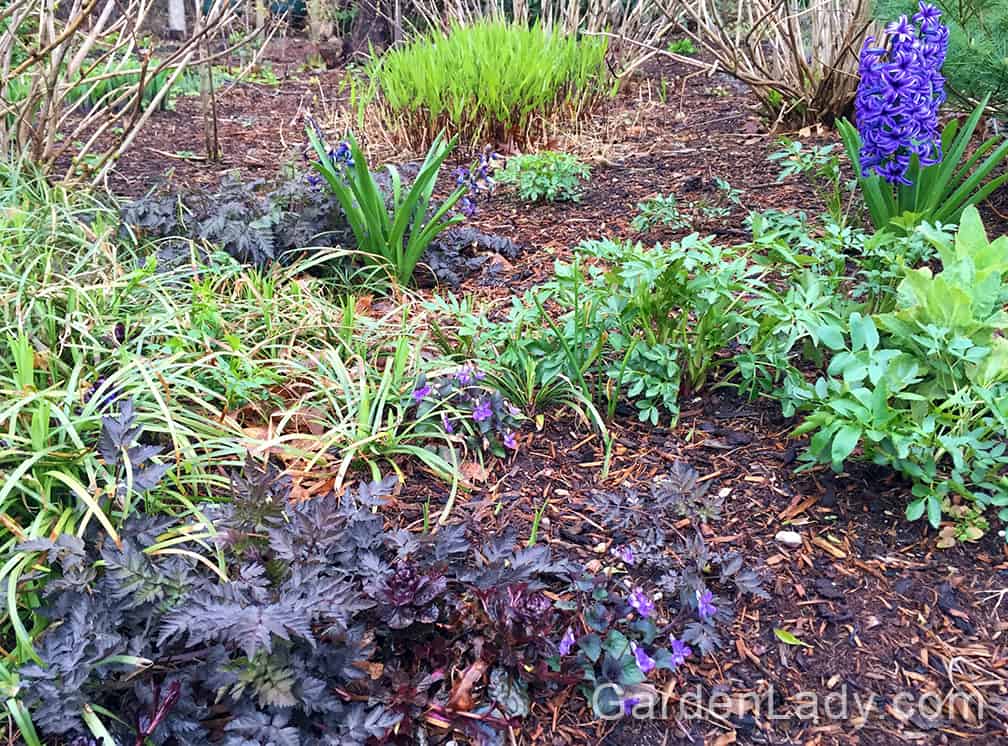In past posts I’ve made it clear that I don’t want common violets (Viola odorata) on Poison Ivy Acres. I will periodically spot a flowering plant or two in the spring, and I am quick to dig it out. They have deep, thick roots so just a quick tug doesn’t do the job. The plants I’ve dug get put in the garbage, not in the compost. Good riddance to bad rubbish.
There is, however, a violet that I love and welcome to my gardens. I have found that Labrador violets are a perfect “plays well with others” plant in my shade garden. And they grow well from seed: LABRADOR VIOLET * Viola labradorica purpurea * GORGEOUS PURPLE FOLIAGE * SEEDS.
I remember when I first saw this plant. I was visiting a fellow volunteer master gardener, Eleanor Seaman, in the mid-1990’s. She had a healthy stand of them growing, and said something like, “You just have to be willing to let them wander.” And then she dug some and gave them to me.
Viola labradorica have purple foliage, especially early in the season. They are smaller than common violets, and although they self-seed, they aren’t as aggressive as their cousins. They play well with others, and happily mingle with other shade perennials, so I am willing to let them wander.

As my shade garden wakes up, and perennials emerge from seemingly bare earth, the Labrador violets seem to bloom in celebration.

Even in part-sun, they coexist with low sedum and other small plants.

I keep one eye on extremely fragrant, extra delicious Viola odorata ‘Couer d’Alsace’. It often starts blooming in February here on the Cape. Worth the vigilance.
You’re a more patient gardener than I, Marcia!
I totally disagree, it is absolutely invasive! I have two hanging wall pots I put them in. Ever since, they have worked themselves into every potted plant I have and in any nearby ground areas, even in the cracks of cement! I have never seen anything like it ever. I have to wait until winter when main plants go dormant, then try to pull out as much as I can. Even then, I doubt I will get it all. Be careful with this cute little plant, after flowers are done, they form seed pods, when seed pods dry, they crack open spreading the seeds like popcorn everywhere!
Rainey,
Your experience with Labrador violets points out that a plant that’s well-mannered in one area might be a thug somewhere else. Another example of all gardening being regional! For me, this politely self-seeds in my shade garden but I’ve never seen a single plant in the lawn, driveway or anywhere else. Thanks for reminding others that just because a plant behaves well for me on Cape Cod doesn’t mean it will be the same elsewhere.
V. Labradorite does not have burgundy foliage
There is a difference in behavior between the Labrador Violet and the European dog violet. The Viola labradorica sold by nurseries is usually the European Viola riviniana. And yes, it is very aggressive, and I ripped it out quickly . If you have a source for Viola labradorica, please post or send. I can’t find it for sale anywhere, either plant or seed. Lots of Viola riviniana masquerading as Viola labradorica.
Anne,
Don’t you hate when that happens? I’ve been annoyed recently that there are many plants masquerading as African Blue Basil that are not even close to the original. Sigh. I wish I could give you a source but I got mine over 20 years ago from a friend. Who knows….it might be V. riviniana, but it’s not a thug and sweetly behaved in my garden.
We bought some today from Hodge Nursery in Durham, CA.
You are correct Ann Furman- so glad you pointed that out- it is mistaken for V. Labradorica all the time.